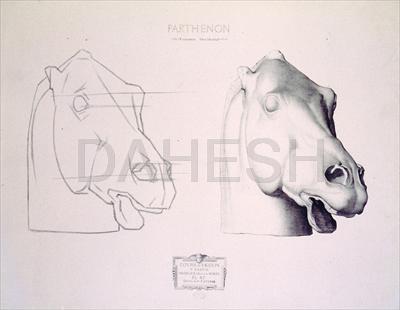Charles Bargue (French, 1826/7–1883)
Horse Head from the West Pediment of the Parthenon (after a drawing by Jean Lecomte du Nouÿ), ca. 1868
From the Drawing Course (Cours de Dessin). “Part I: Drawing after Casts (Modèles d’Après la Bosse),” plate I, 47. Paris: Goupil & Cie, 1868.
Lithograph on gray paper, 18 9/16 x 24 in.
Inscribed lower center: COURS de DESSIN Ier PARTIE MODÈLES d’Après La Bosse PL 47 / Goupil & Cie Editeurs
2000.8

Before studying plaster casts or live models, art students usually tried to master the skill of drawing by copying two-dimensional images. They did so on their own or with teachers, with the help of manuals or drawing courses. One of the more famous drawing courses was compiled by the painter and lithographer Charles Bargue, in collaboration with the leading academician Jean-Léon Gérôme, and published by the art dealer Adolphe Goupil between 1868 and 1873. This Drawing Course (Cours de Dessin) contained 197 loose-leaved lithographs divided over three volumes, each focusing on a different area of practice.
The first volume provided examples of plaster casts, with a rudimentary abstraction of the general form of the model next to a finished version of the same object for many of the plates. Horse Head from the West Pediment of the Parthenon breaks down the difficult form of the horse’s anatomy into simplified angles and horizontal lines connecting related features to assist the novice student and instruct him in how to deconstruct complex images. Bargue produced his lithographs from drawings made by other artists after celebrated plaster casts. Horse Head was made after a drawing by Gérôme’s student, Lecomte du Nouÿ. While the original inscription on the plate indicates that the horse’s head comes from the west pediment of the Parthenon, it is actually from the east pediment of that structure (now located in the British Museum, London).


